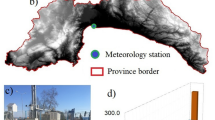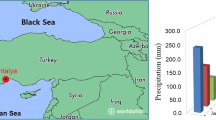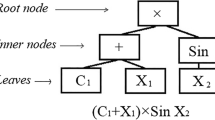Abstract
A precise forecast of streamflow in intermittent rivers is of major difficulties and challenges in watershed management, particularly in arid and semiarid regions. The present research study introduces an ensemble gene expression programming (EGEP) modeling approach to 1- and 2-day ahead streamflow forecasts that meet both accuracy and simplicity criteria of an applied model. Three main components of the proposed EGEP approach which are capable of producing a parsimonious model include (i) creating a population of suitable solutions using classic genetic programming (GP) instead of a single solution, (ii) combining the solutions throughout gene expression programming, and (iii) parsimony selection based upon trade-off analysis between the complexity and accuracy of the best-evolved solutions at the holdout validation set. The EGEP model was trained and verified using the streamflow measurements from the Shahrchay River lying northwest of Iran. Several statistical indicators were computed for verification of the ensemble models’ accuracy with that of classic GP and artificial neural network models developed as the benchmarks. Our results revealed that the EGEP outperforms the benchmarks. It is an explicit, simple, and precise approach and, therefore, worthy to be used in practice.













Similar content being viewed by others
References
ASCE Task Committee on Application of Artificial Neural Networks in Hydrology (2000) Artificial neural networks in hydrology. I: preliminary concepts. J Hydrol Eng 5(2):115–123
Al-Juboori AM, Guven A (2016) A stepwise model to predict monthly streamflow. J Hydrol 543:283–292
Babovic V, Keijzer M (2000) Genetic programming as a model induction engine. J Hydroinf 2(1):35–60
Brameier M, Banzhaf W (2001) A comparison of linear genetic programming and neural networks in medical data mining. IEEE Trans Evol Comput 5(1):17–26
Chuntian C, Chau KW (2002) Three-person multi-objective conflict decision in reservoir flood control. Eur J Oper Res 142(3):625–631
Danandeh Mehr A (2018) An improved gene expression programming model for streamflow forecasting in intermittent streams. J Hydrol 563:669–678
Danandeh Mehr A, Kahya E (2017) A Pareto-optimal moving average multigene genetic programming model for daily streamflow prediction. J Hydrol 549:603–615
Danandeh Mehr A, Nourani V (2017) A Pareto-optimal moving average-multigene genetic programming model for rainfall-runoff modelling. Environ Model Softw 92:239–251
Danandeh Mehr A, Jabarnejad M, Nourani V (2019) Pareto-optimal MPSA-MGGP: a new gene-annealing model for monthly rainfall forecasting. J Hydrol 571:406–415
Danandeh Mehr A, Nourani V, Kahya E, Hrnjica B, Sattar AM, Yaseen ZM (2018) Genetic programming in water resources engineering: a state-of-the-art review. J Hydrol 566:643–667
Danandeh Mehr A, Kahya E, Şahin A, Nazemosadat MJ (2015) Successive-station monthly streamflow prediction using different artificial neural network algorithms. Int J Environ Sci Technol 12(7):2191–2200
Danandeh Mehr A, Nourani V (2018) Season algorithm-multigene genetic programming: a new approach for rainfall-runoff modelling. Water Resour Manag 32(8):2665–2679
de Vos NJ, Rientjes THM (2008) Correction of timing errors of artificial neural network rainfall-runoff models. In: Abrahart RJ, See LM, Solomatine DP (eds) Practical hydroinformatics, computational intelligence and technological developments in water applications. Springer, Berlin, p 101e112
Demirel MC, Venancio A, Kahya E (2009) Flow forecast by SWAT model and ANN in Pracana basin, Portugal. Advances in Engineering Software 40(7),467–473
Ferreira C (2001) Gene expression programming: a new adaptive algorithm for solving problems. arXiv. preprint cs/0102027
Ferreira C (2006) Gene expression programming: mathematical modeling by an artificial intelligence, vol 21. Springer
Fotovatikhah F, Herrera M, Shamshirband S, Chau KW, Faizollahzadeh Ardabili S, Piran MJ (2018) Survey of computational intelligence as basis to big flood management: challenges, research directions and future work. Eng Appl Comput Fluid Mech 12(1):411–437
Freire PKDMM, Santos CAG, da Silva GBL (2019) Analysis of the use of discrete wavelet transforms coupled with ANN for short-term streamflow forecasting. Appl Soft Comput 80:494–505
Ghorbani MA, Khatibi R, Danandeh Mehr A, Asadi H (2018a) Chaos-based multigene genetic programming: a new hybrid strategy for river flow forecasting. J Hydrol 562:455–467
Ghorbani MA, Kazempour R, Chau KW, Shamshirband S, Taherei Ghazvinei P (2018b) Forecasting pan evaporation with an integrated artificial neural network quantum-behaved particle swarm optimization model: a case study in Talesh, northern Iran. Eng Appl Comput Fluid Mech 12(1):724–737
Giustolisi O (2004) Using genetic programming to determine Chezy resistance coefficient in corrugated channels. J Hydroinf 6(3):157–173
Hadi SJ, Tombul M (2018) Monthly streamflow forecasting using continuous wavelet and multi-gene genetic programming combination. J Hydrol 561:674–687
Hrnjica B, Danandeh Mehr A (2019) Optimized genetic programming applications: emerging research and opportunities: emerging research and opportunities. IGI Global. Hershey, PA, pp. 1–310
Hrnjica B, Danandeh Mehr A (2020) Energy demand forecasting using deep learning. In: Smart cities performability, cognition, & security. Springer, Cham, pp 71–104
Hinchliffe M, Willis M, Tham M (1998) Chemical process systems modelling using multiobjective genetic programming. In proceeding of third annual confrence on genetic programming, University of Wisconsin at Madison, Morgan Kaufmann Publishers. San Mateo, California, 134–139
Krause P, Boyle DP, Bäse F (2005) Comparison of different efficiency criteria for hydrological model assessment. Adv Geosci 5:89–97
Kitanidis PK, Bras RL (1980) Real-time forecasting with a conceptual hydrologic model, applications and results. Water Resour Res 16:1034e1044
Kişi Ö (2009) Neural networks and wavelet conjunction model for intermittent streamflow forecasting. J Hydrol Eng 14(8):773–782
Kisi O, Nia AM, Gosheh MG, Tajabadi MRJ, Ahmadi A (2012) Intermittent streamflow forecasting by using several data driven techniques. Water Resour Manag 26(2):457–474
Kisi O, Sanikhani H, Cobaner M (2017) Soil temperature modeling at different depths using neuro-fuzzy, neural network, and genetic programming techniques. Theor Appl Climatol 129(3–4):833–848
Karimi S, Shiri J, Kisi O, Shiri AA (2016) Short-term and long-term streamflow prediction by using wavelet–gene expression programming approach. ISH J Hydraul Eng 22(2):148–162
Koza JR (1992) Genetic programming: on the programming of computers by means of natural selection, vol 1. MIT Press. Cambridge, Massachusetts
Legates DR, McCabe Jr, GJ (1999) Evaluating the use of “goodness‐of‐fit” measures in hydrologic and hydroclimatic model validation. Water Resources Research 35(1),233–241
Liong SY, Gautam TR, Khu ST, Babovic V, Keijzer M, Muttil N (2002) Genetic programming: a new paradigm in rainfall runoff modeling 1. JAWRA J Am Water Resourc Assoc 38(3):705–718
Maier HR, Dandy GC (2000) Neural networks for the prediction and forecasting of water resources variables: a review of modelling issues and applications. Environ Model Softw 2000(15):101–124
Nourani V, Komasi M, Alami MT (2012) Hybrid wavelet genetic programming approach to optimize ANN modelling of rainfall-runoff process. J Hydrol Eng 17(6):724e741
Rajaee T, Ebrahimi H, Nourani V (2019) A review of the artificial intelligence methods in groundwater level modeling. J Hydrol 572:336–351
Ravansalar M, Rajaee T, Kisi O (2017) Wavelet-linear genetic programming: a new approach for modeling monthly streamflow. J Hydrol 549:461–475
Ryu S, Noh J, Kim H (2016) Deep neural network based demand side short term load forecasting. Energies 10(1):3
Sachindra DA, Ahmed K, Rashid MM, Sehgal V, Shahid S, Perera BJC (2019) Pros and cons of using wavelets in conjunction with genetic programming and generalised linear models in statistical downscaling of precipitation. Theor Appl Climatol:1–22. https://doi.org/10.1007/s00704-019-02848-2
Shaeri Karimi S, Yasi M, Eslamian S (2012) Use of hydrological methods for assessment of environmental flow in a river reach. Int J Environ Sci Technol 9(3):549–558
Sheela KG, Deepa SN (2013) Review on methods to fix number of hidden neurons in neural networks. Math Probl Eng 425740:1–11. https://doi.org/10.1155/2013/425740
Shoaib M, Shamseldin AY, Melville BW, Khan MM (2015) Runoff forecasting using hybrid wavelet gene expression programming (WGEP) approach. J Hydrol 527:326–344
Singh VP (2018) Hydrologic modeling: progress and future directions. Geosci Lett 5(1):15
Sudheer KP, Gosain AK, Ramasastri KS (2002) A data-driven algorithm for constructing artificial neural network rainfall-runoff models. Hydrol Process 16(6):1325–1330
Van Ooyen A, Nienhuis B (1992) Improving the convergence of the back-propagation algorithm. Neural Netw 5(3):465–471
Wang WC, Chau KW, Cheng CT, Qiu L (2009) A comparison of performance of several artificial intelligence methods for forecasting monthly discharge time series. J Hydrol 374(3):294–306
Wang WC, Chau KW, Qiu L, Chen YB (2015) Improving forecasting accuracy of medium and long-term runoff using artificial neural network based on EEMD decomposition. Environ Res 139:46–54
Wu CL, Chau KW, Li YS (2009) Methods to improve neural network performance in daily flows prediction. J Hydrol 372:80–93
Wu CL, Chau KW (2010) Data-driven models for monthly streamflow time series prediction. Eng Appl Artif Intell 23(8):1350–1367
Wu CL, Chau KW (2013) Prediction of rainfall time series using modular soft computing methods. Eng Appl Artif Intell 26(3):997–1007
Yaseen ZM, Ebtehaj I, Bonakdari H, Deo RC, Mehr AD, Mohtar WHMW et al (2017) Novel approach for streamflow forecasting using a hybrid ANFIS-FFA model. J Hydrol 554:263–276
Yaseen ZM, Mohtar WHMW, Ameen AMS, Ebtehaj I, Razali SFM, Bonakdari H, Salih SQ, al-Ansari N, Shahid S (2019a) Implementation of univariate paradigm for streamflow simulation using hybrid data-driven model: case study in tropical region. IEEE Access 7:74471–74481
Yaseen ZM, Sulaiman SO, Deo RC, Chau KW (2019b) An enhanced extreme learning machine model for river flow forecasting: state-of-the-art, practical applications in water resource engineering area and future research direction. J Hydrol 569:387–408
Acknowledgments
The authors thank Western Azerbaijan Regional Water Authority (agrw.ir) for providing streamflow data used in this research study. Insightful comments from the three anonymous reviewers are gratefully appreciated.
Author information
Authors and Affiliations
Corresponding author
Additional information
Publisher’s note
Springer Nature remains neutral with regard to jurisdictional claims in published maps and institutional affiliations.
Appendix
Appendix
Dimensionless gene expression trees of the parsimonious EGEP models developed for daily streamflow prediction in Shahrchay River
Same as Fig. 12, but for 2-day ahead forecasts
Rights and permissions
About this article
Cite this article
Rahmani-Rezaeieh, A., Mohammadi, M. & Danandeh Mehr, A. Ensemble gene expression programming: a new approach for evolution of parsimonious streamflow forecasting model. Theor Appl Climatol 139, 549–564 (2020). https://doi.org/10.1007/s00704-019-02982-x
Received:
Accepted:
Published:
Issue Date:
DOI: https://doi.org/10.1007/s00704-019-02982-x






